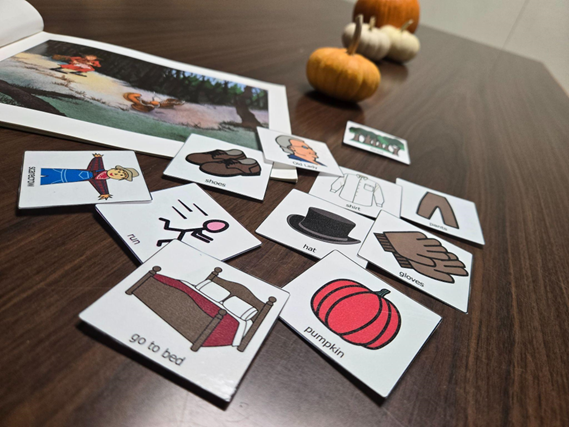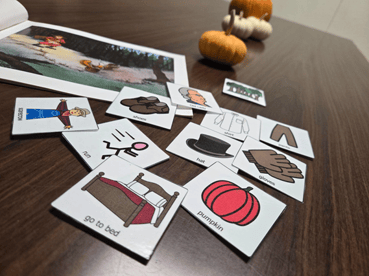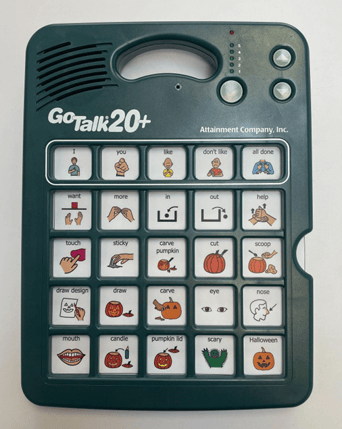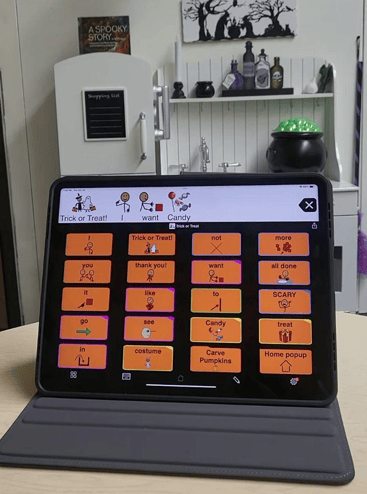
Spookt-AAC-ular Ideas for Supporting Communication in AAC Users
As the leaves change and the air turns crisp, fall brings us a wealth of opportunities for meaningful communication practice.
Halloween and the traditions that surround it offer AAC users a motivating context for learning and using new vocabulary. SLPs know the best time to introduce a new target to an AAC user is when the language is meaningful and the context for its use is genuinely motivating.
Fall holidays provide exactly this kind of magic. Seasonal stories, autumn crafts and celebrations create natural opportunities for communication that feel important and fun, rather than forced or clinical.
Here are a few ideas to leverage the magic of the season with your multi-modal communicators:
1. Adapted Storybook Reading
Create low-tech visuals or high-tech grids containing the vocabulary you'll be targeting during motivating seasonal storybook reads, especially if your AAC user will be exposed to these books in their small group therapy sessions or in their classroom. When students encounter the same vocabulary in therapy and in their classroom, learning is reinforced naturally.
Don't forget to include:
- Participation words that allow them to engage in the shared reading experience (e.g., TURN PAGE, MORE, YES, NO)
- Core vocabulary that supports commenting and requesting (e.g., SEE, TAKE, LIKE, GO)
- Fringe vocabulary related to the story's content (e.g., SKELETON, CANDY, HIDE, NIGHT, DARK, AFRAID)
- Options for commenting that let them share their reactions (e.g., I LIKE THAT, DON'T LIKE, SCARY, WOW, FUNNY)
The key is to model these words naturally as you read, giving your AAC user time to process and respond. Point to or activate the words on their system as you encounter them in the story, showing them how the vocabulary connects to what's happening on the page.

Example: Shown here are low-tech visual icons to support a shared reading of "The Little Old Lady Who Wasn't Afraid of Anything." Adults can use the pictures as cues to support participation or elicit approximations, while students might use the icons to participate, answer questions, or retell the story.
2. Support Participation in Seasonal Activities and Crafts
Hands-on activities like pumpkin carving or leaf art are naturally engaging and rich with communication opportunities. Create low-tech visuals or high-tech grids containing vocabulary specific to the activity you're doing together.
Consider including:
- Action words (CUT, SCOOP, GLUE, PAINT, CARVE, DUMP, WASH)
- Descriptive language (MESSY, SLIMY, STICKY, ORANGE, BIG, LITTLE)
- Requesting and protesting (MY TURN, HELP, MORE, ALL DONE, STOP)
- Commenting (LOOK, COOL, GROSS, I DID IT)
These activities engage multiple senses, are socially motivating, and naturally capture students' engagement—giving AAC users the opportunity to use the targets in an immediately meaningful context. Because they're actively participating, the vocabulary isn't abstract or decontextualized; it's connected to what their hands are doing and what they're experiencing in real time.

Example: Pictured is a mid-tech board designed for a GoTalk device to support pumpkin carving, featuring all the words needed to be a full participant in the messy, wonderful process.
3. Practice Trick-or-Treating with Customized Boards
AAC users may not approach the celebrated tradition of trick-or-treating with the same eagerness as typically developing children. The social demands of approaching stranger after stranger, the unpredictability of who will answer the door, and the need to communicate quickly in a busy environment can be overwhelming.
Multi-modal communicators may benefit from practice in order to build the confidence needed to interact with so many unfamiliar communication partners on Halloween night. Therapy time in the weeks leading up to Halloween is the perfect opportunity to rehearse, model, and refine their strategy.
You may find that your AAC user's communication device is lacking in specificity when it comes to their actual preferences. Do they love a particular kind of candy? Are they excited to tell people about their superhero costume? Do they want to be able to say more than just "trick or treat"?
After speaking with the AAC user (or their family, if necessary), create a board or customize their existing system to suit their needs. Then use therapy time to practice modeling and using the new targets. Set up mock doors in your therapy room, take turns being the trick-or-treater and the neighbor, and let them build confidence through repetition.
Make sure to include:
- Traditional phrases (TRICK OR TREAT, THANK YOU, HAPPY HALLOWEEN)
- Candy preferences (CHOCOLATE, CANDY BAR, NO PEANUTS, JUST ONE)
- Social comments (I LIKE YOUR DECORATION, COOL COSTUME, GOODBYE)
- Information about their costume (I'M A DINOSAUR, SEE MY CAPE, I'M SPIDERMAN)
- For high-tech AAC users, this can be an excellent time to explore fun character voices (accessible in the settings of most high-tech devices). Imagine trick-or-treating as a robot, a princess, or a monster—complete with a voice to match!

Example: Shown is a high-tech vocabulary grid for Proloquo2Go users with dynamic display, designed specifically for trick-or-treating. Embedded in this grid are several folders with additional targets related to costumes, decorations, and seasonal activities.
A Note on Creating Materials
If you need support creating low-tech visuals, programming mid-tech devices, or customizing high-tech systems, reach out to your AAC-savvy colleagues or your district's AAC specialist. Remember, AAC doesn't need to be high tech or perfect to be functional and motivating to your students.
Pr-AACtical Magic
Fall holidays offer a golden opportunity to introduce and practice AAC vocabulary in contexts that actually matter to your students. When motivation is intrinsic, the language learning that follows is powerful and lasting.
So this season, lean into the pumpkins, the costumes, the stories, and the candy. Your AAC users will thank you for it—perhaps with their newly customized Halloween boards.
Author: Alexandra Redfern, M.S., CCC-SLP
Disclaimer: The information provided in this blog is for general informational purposes only and should not be considered as professional advice. The content is based on the author's personal experiences, research, and opinions. It is always recommended to consult with a qualified professional or expert before making any decisions or taking action based on the information provided in this blog.
